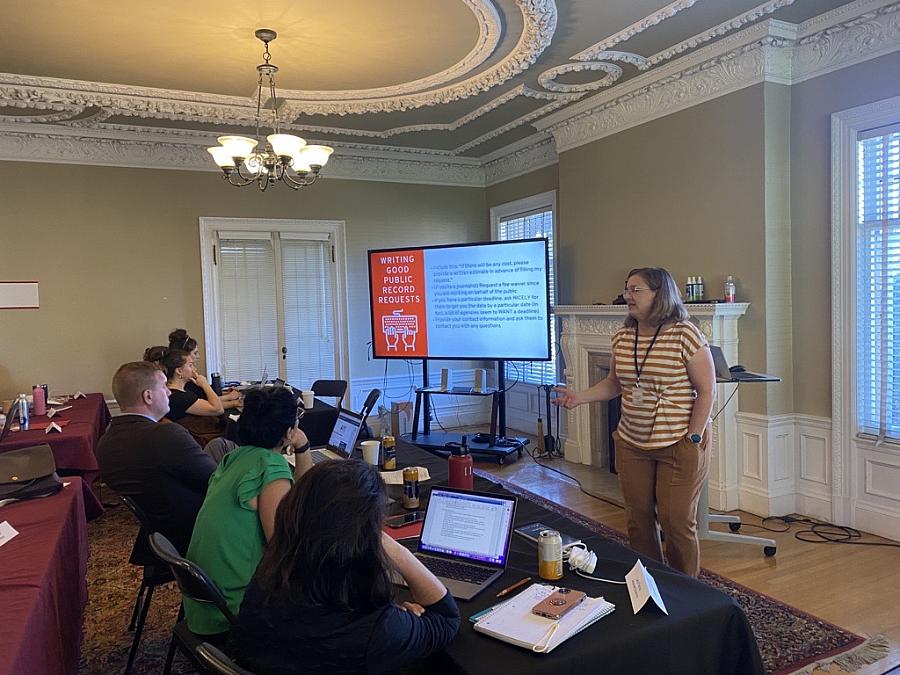There are endless public records, but how do you access them? Two data experts share advice

MaryJo Webster speaks to journalists taking part in the 2023 Data Fellowship in Los Angeles last week.
(Photo by Cassandra Garibay/CHJ)
There are thousands of government agencies across the country that are required to keep public records. But for that information to become publicly accessible, someone must know how to ask for it and exactly what to ask for.
Data journalists MaryJo Webster and Marissa Evans shared invaluable lessons on how to go about making public records public with fellows at last week’s 2023 Data Fellowship.
As Webster put it, reporters have to do their homework before filing requests for information.
Webster, who leads the data team at the Minneapolis Star Tribune and serves as a Senior Fellow for the Data Fellowship, shared tips about public records requests that she has learned from her two decades of data journalism experience.
Evans is a health and culture reporter for the Los Angeles Times and a former colleague of Webster’s at the Minneapolis Star Tribune. On Thursday, she shared examples of how data requests led her to powerful stories throughout her career.
“There are a lot of levels of complication,” Webster said of public records. “I've learned over the years that you can prevent a lot of that complication with some upfront work.”
For Webster, that upfront work involves understanding what records government agencies are required to track, what state or local public record laws are in place in the region of coverage, what the data the journalist is seeking is used for, and how the data or records are formatted.
“Part of the challenge is figuring out, ‘What do they have and what does it look like?’” Webster said.
Webster added that knowing the laws on public records can also ensure that journalists are not being overcharged for public information. For Webster, knowing the Minnesota laws on how much an agency can charge for public records has saved her and her newsroom thousands of dollars, she said.
Webster also advised reporters to seek out the records keeper in any given agency and have a conversation with that person before filing a records request; doing so will help reporters better understand what data is available and file a more precise request. Webster said over the years, her records requests have become more specific, typically including a deadline for the records, the format she would like to receive the records in, and the type of software she will be analyzing the data in.
Webster said that providing the precise details of a request at the beginning can save time and confusion when seeking information from government agencies.
Evans echoed Webster’s advice, and stressed the importance of record retention schedules, which list out what records agencies keep and when.
“Think of all the reports throughout the year that we just don’t read that these agencies are required to put out there to … justify their funding, to justify why they shouldn't be sunset in X number of years,” Evans said. “It's a good exercise, a good habit to just read through what is out there.”
For Evans, part of “fostering a FOIA mindset” is not only having the skills needed to seek out information, but the curiosity to do so.
“We can teach you how to write a public record request, right? We can teach you in Excel to do a pivot table. Those are very tangible things,” Evans said. “I cannot teach you how to be curious. I think we're in a profession that requires us to be curious.”
Evans said curiosity is what has led her to some crucial public records requests throughout her career, which in turn resulted in impactful journalism. She encouraged reporters to be broadly curious and draw story inspiration from everywhere.
In one case, Evans said she was reading an article about a program related to medical debt in South Dakota and there was a brief mention of a similar program in Minnesota, where she was reporting. That led Evans down a reporting path that uncovered how tax refunds were being used to pay off medical debts in Minnesota. The reporting involved analyzing thousands of rows of hospital data and resulted in committee hearings and bill proposals in the Minnesota legislature, Evans said.
“It’s led to impact journalism,” Evans said. “So, that’s another example of being tenacious with data and catching one little blip in a story.”
